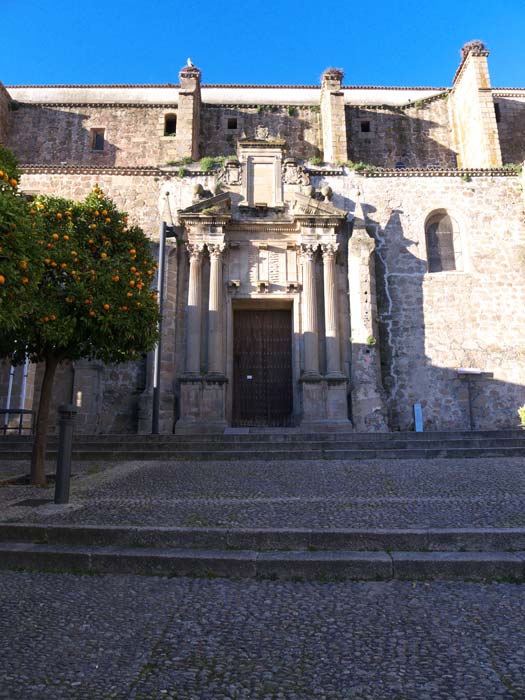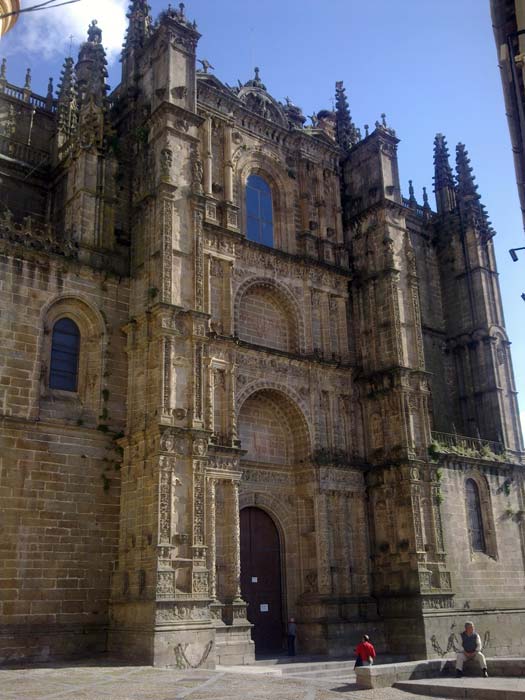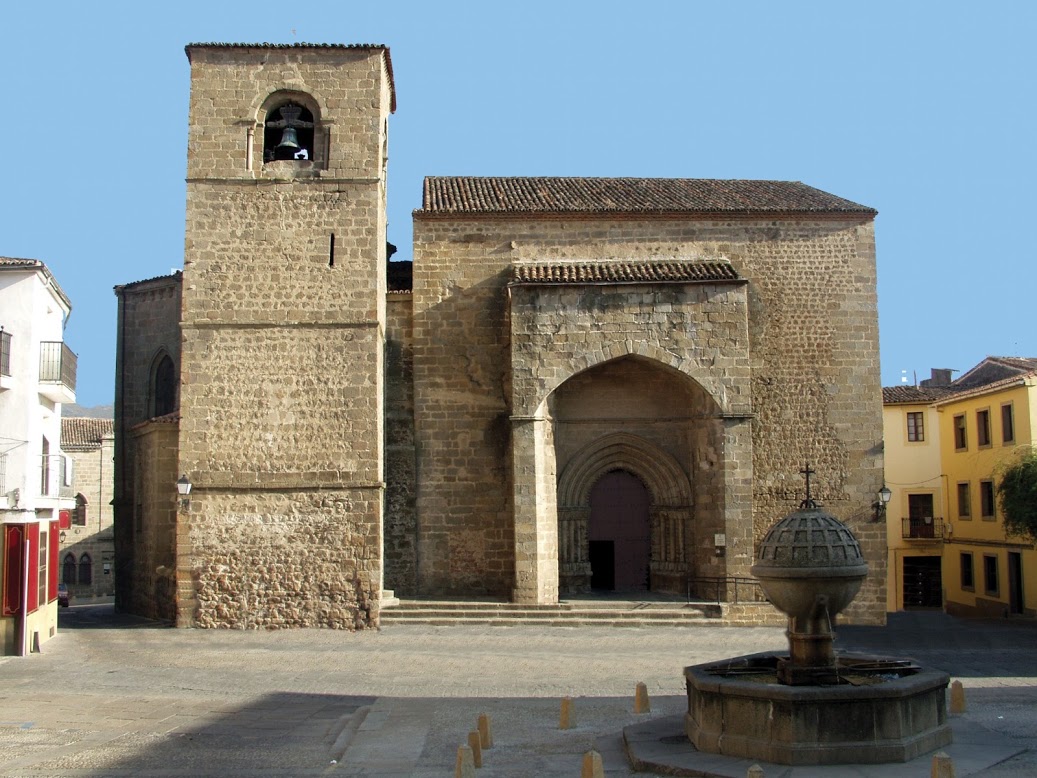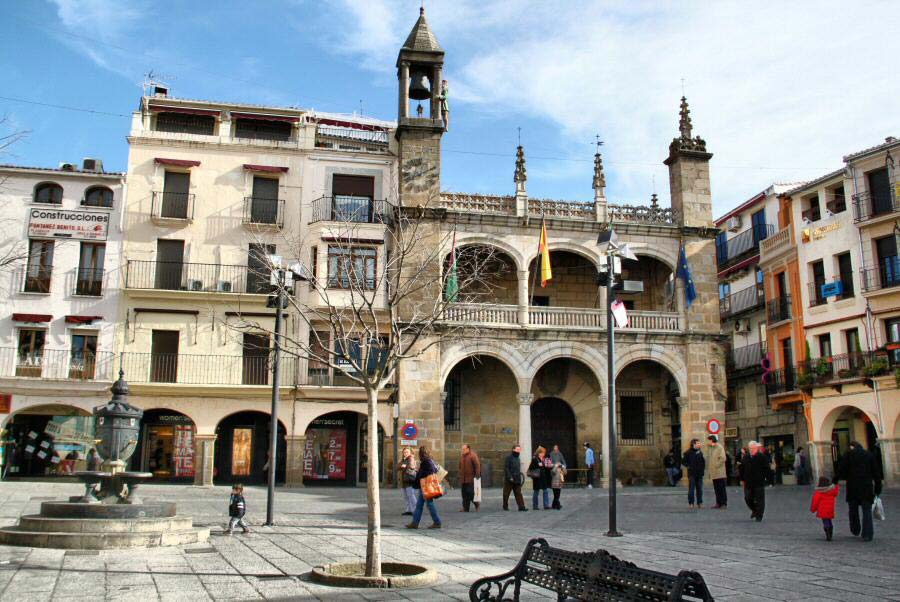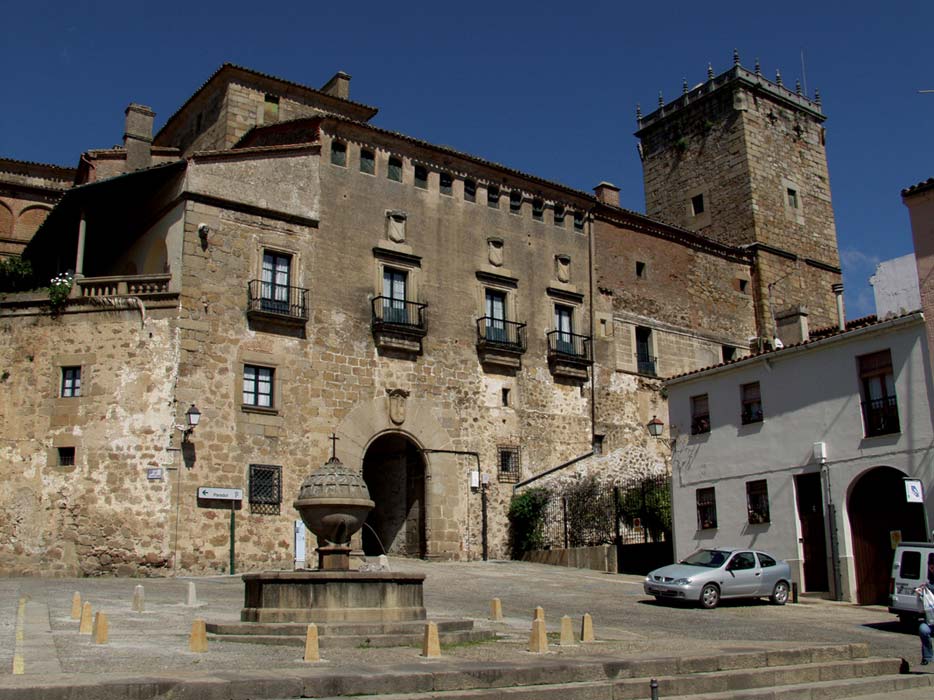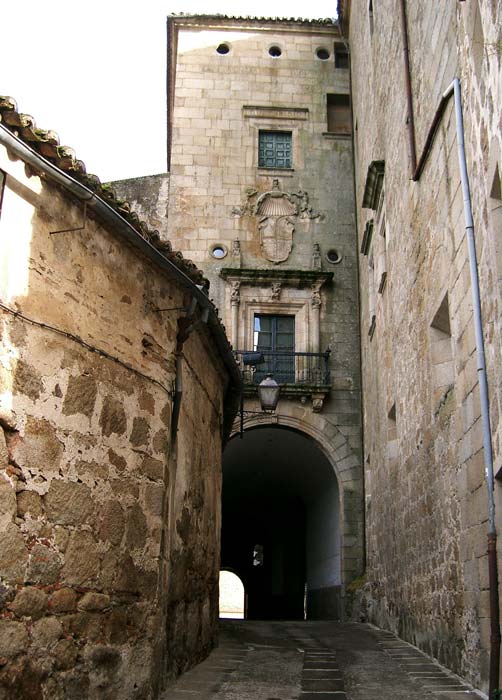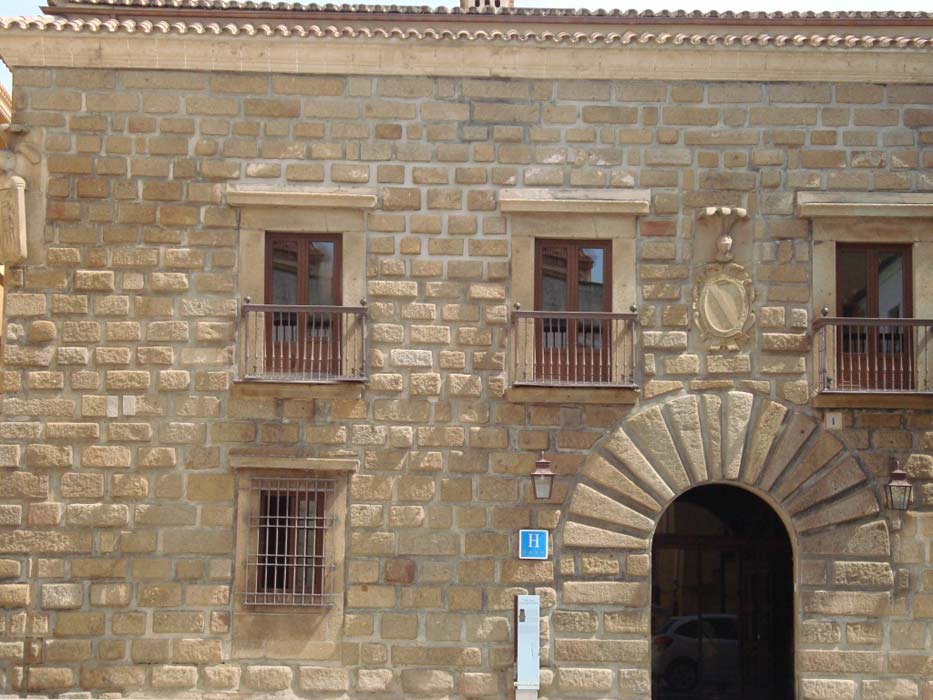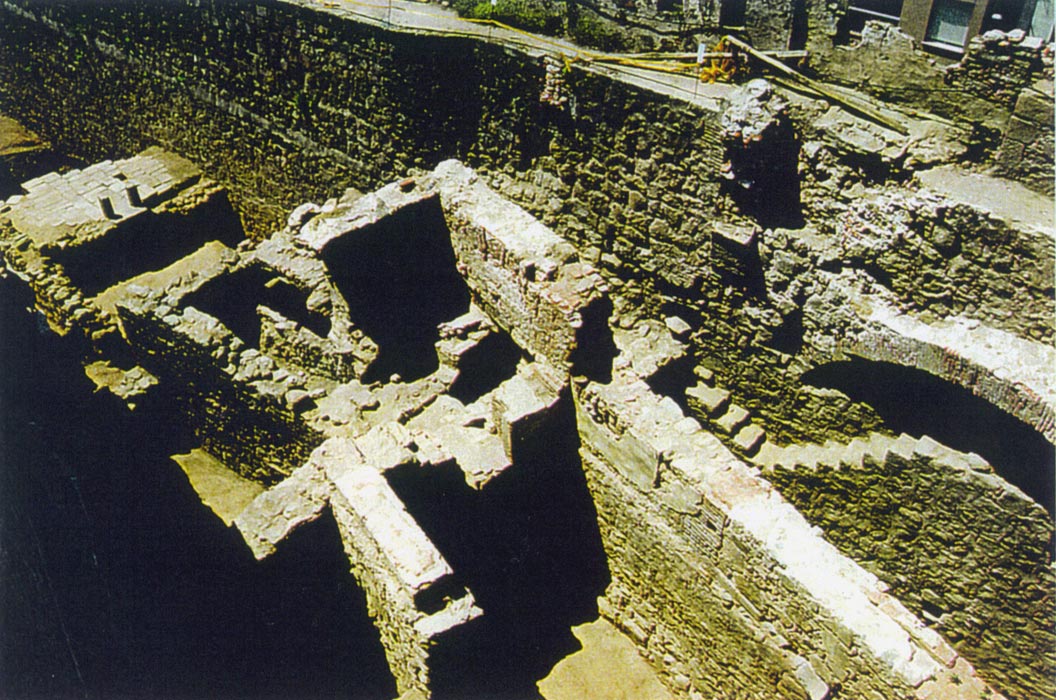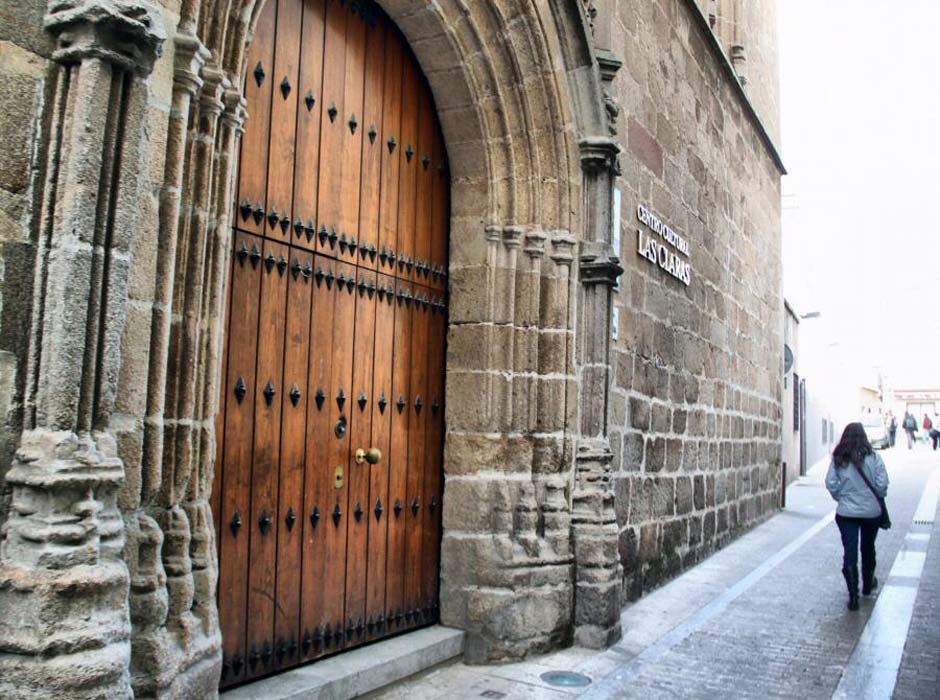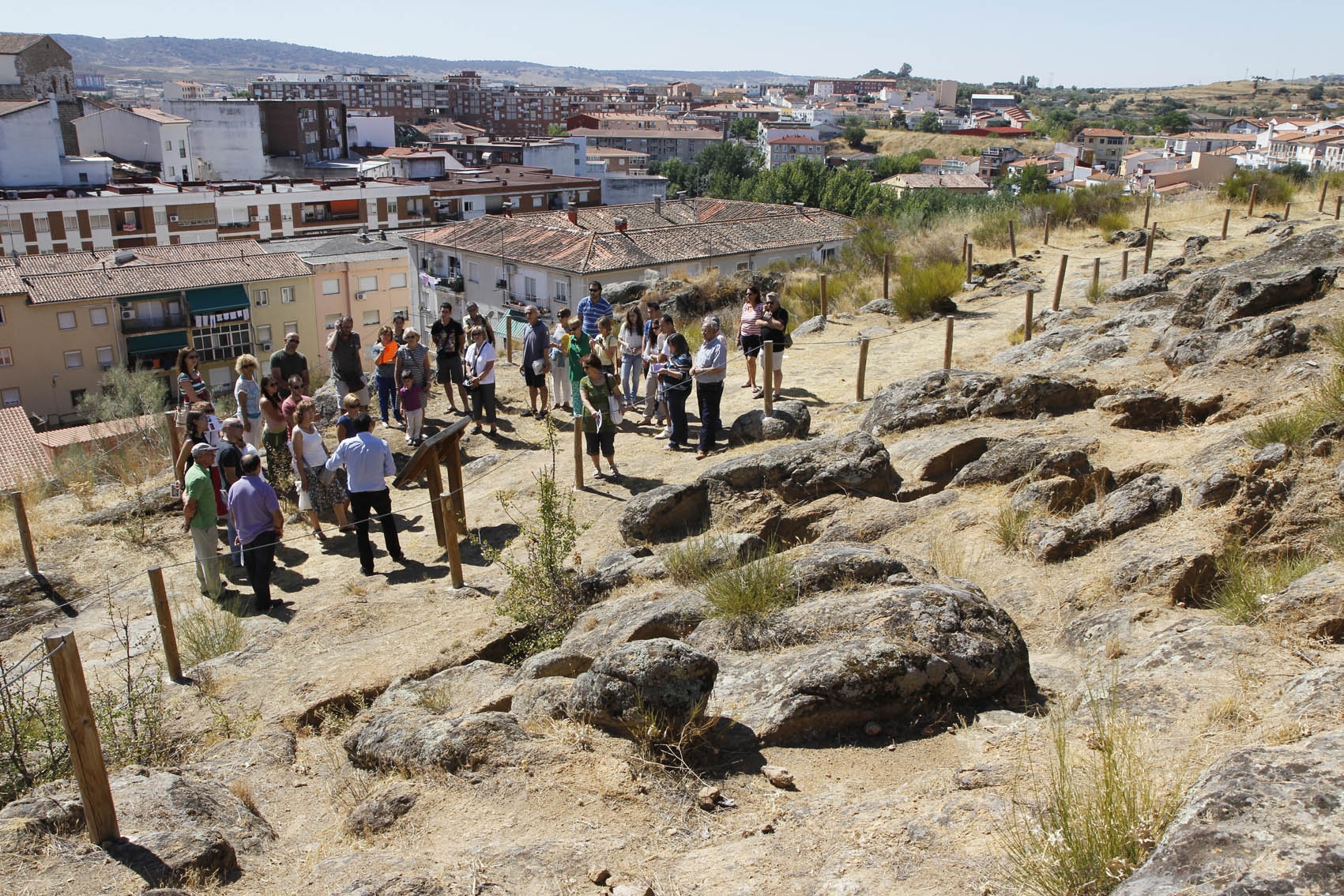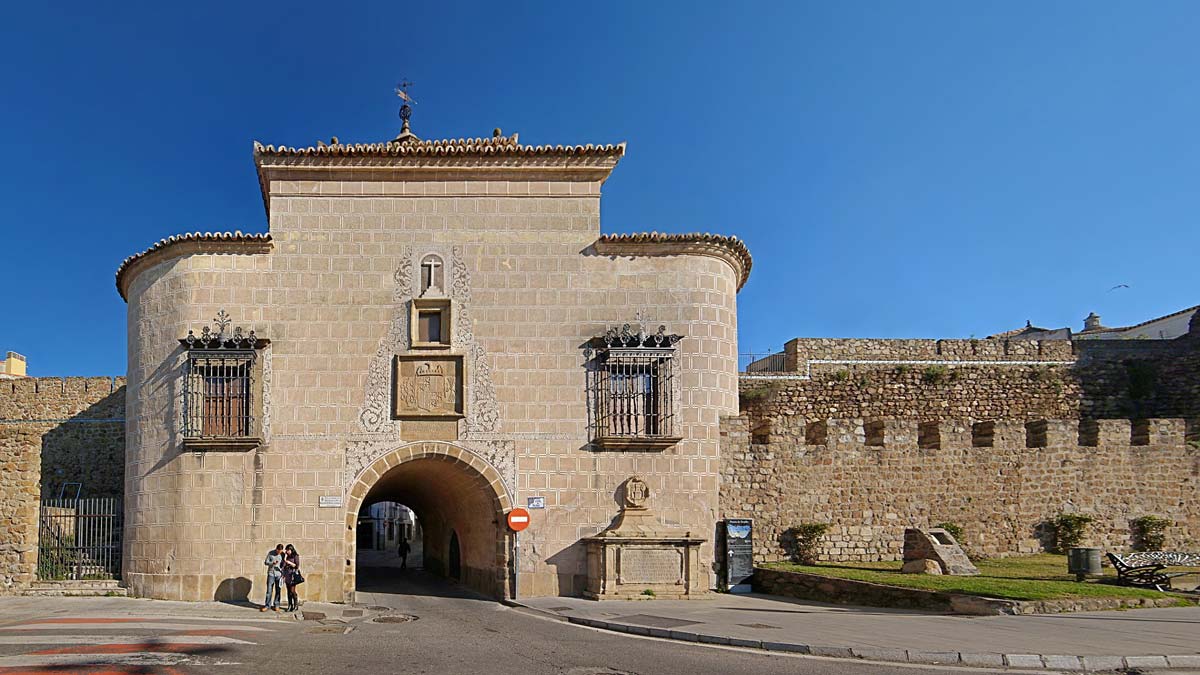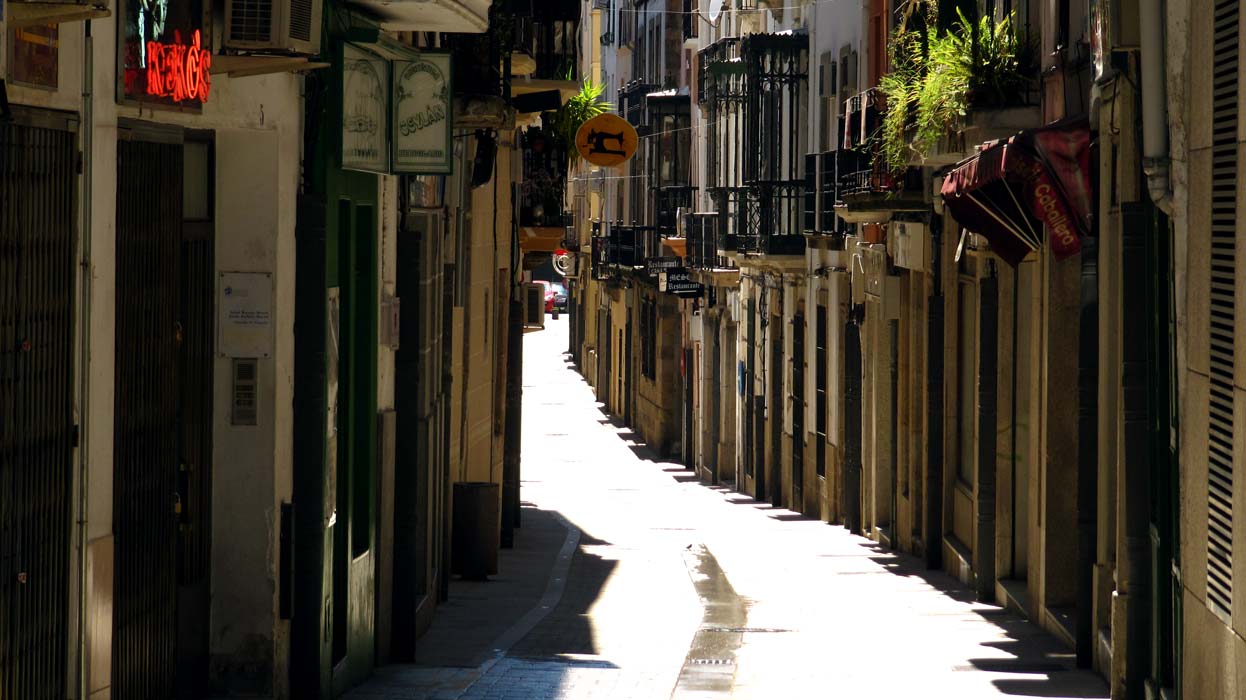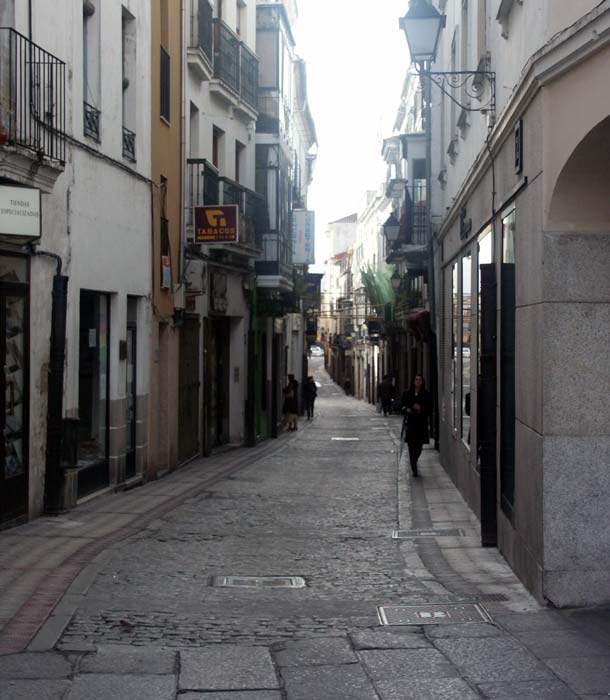The cohabitation for centuries of Jews and Christians at different sites in the city,
with the sole exception of the segregations of 1412-1420 and 1480-1492, means that
following the tracks of the Jewish collective from Plasencia also means discovering,
on the way, a large part of the monumental wealth of the walled city, from the main
square to the gates of Trujillo and Berrozana, passing via the cathedral or the magnificent
St. Vincent Ferrer convent and the palace of Marqués de Mirabel. The map of Jewish Plasencia is thus overlaid onto the traditional segmentation of the city
between the districts of Los Caballeros, Los Clérigos and Los Mercaderes, allowing
a route to be followed which combines the traditional monumental area with other hitherto
unheard of or less well-known spots.
Founded in 1186 by the Castilian King Alfonso VIII on the Banks of the river Jerte
under the motto tu placeat Deo et hominibus (so it will please God and men), since its very outset Plasencia has enjoyed the
presence of a major Jewish community as is confirmed back in 1189 in the charter granted
by the monarch to the city. Although its first site was in La Mota, in the higher
part of the city, protected by the citadel and the powerful wall of Plasencia, during
the 13th and 14th centuries many of them settled in other parts of the city, essentially
between the main square and Zapatería and Trujillo streets.
After the establishment of the episcopal seat in 1189, the Jews settled in the towns
of Béjar (Salamanca), Trujillo (Cáceres) Medellín (Badajoz) and Plasencia (Cáceres). These four settlements were fortified and guaranteed the physical well-being
of their Jewish and Christian inhabitants in the face of the constant dangers raised
by the Almohad infiltration into the border territories of Alta Extremadura. These
town halls also enjoyed a special legal provision granted by the monarchs and based
on the strict legal dependence of the Jews on the Crown, falling outside the jurisdiction
of the institutions of the urban council and the diocese of Plasencia.
Of the four aljamas in the diocese in the late 13th century, set up in Plasencia,
Béjar, Medellín and Trujillo, that of Plasencia is the most economically powerful
though without attaining the demographic development of the large urban aljamas of
Castile. Alfonso VIII of Castile legislated in a wide range of areas governing the
living conditions of the Jews and hence the aljama of Plasencia enjoyed legal autonomy to settle civil and criminal disputes between
Jews at the bet din or Jewish court, administrating justice according to the laws of the Torah. By contrast, mixed trials would be settled at a court of arbitration formed by a
Jewish judge and another Christian one who would meet in the vestibule of the church
of San Nicolás. The charter of Plasencia ensured the Jewish resettlement, «Mosaic»
cultural practice and equality before the law in inter-religious conflicts. The charter
would also regulate the conditions for Jewish lending at interest, the contracting
system and the receipt of usury interest rates, limiting by abuses by the lenders.
The protection provided by Alfonso VIII of Castile to the Jews of Plasencia continued
under the reign of Fernando III (1217-1252). However, the sovereign had to bear in
mind the discriminatory ordinances laid down by Pope Honorius III on January 27th
1217 after the Lateran Council (1215) such as the mandatory use of a distinguishing
emblem on the attire of Jews. The anti-Jewish stipulations of the Pope are contested
by the Archbishop of Toledo, Rodrigo Jiménez de Rada and Honorius III derogates the
order of November 7th 1217, placing the Spanish Jews under apostolic protection. Subsequently,
on the suggestion of Fernando III, on April 13th 1219 the pontiff suspended the anti-Jewish
stipulations of the Lateran Council.
The reign of Alfonso X (1252-1284) was characterised by an initial period favourable
to the Jews covering until 1280. In August 1262 the sovereign granted the royal charter
to the council of the city and land of Plasencia, a charter which Sancho IV (1284-1295)
would confirm in 1290, adding twelve lays to the legal body. The tax division of Huete
(1290-1291) confirmed the operation of four Jewish aljamas in the diocesan jurisdiction
of Plasencia and that of Plasencia was the most economically and demographically powerful
with a contribution of 16.244 maravedis.
The reign of Fernando IV (1295-1312) marked the start of an age of social instability
and outbreaks of Anti-Judaism in Castile. After the ratification of the charter of
Plasencia by Fernando IV and the Queen Mother, María de Molina, in November 1297,
the courts of Medina del Campo of 1305 launched a new attack on the private property
of the Jews, forbidding them to take part in the auction and collection of royal taxes. The directive was conveyed to the councils of the cities and towns of Extremadura and, in particular, to the municipality of Plasencia. The proxies of the Courts of
Valladolid of 1307 asked for the Jews to be excluded from the rental and collection of tax contributions whose legislation is received by the city of Plasencia, but
the ordinances barely have any social impact.
In the first decade of the reign of Pedro I the Cruel (1350-1369), the sovereign sets
out a protectionist policy towards the Jews which bears the hallmark of the royal
favourite Juan Alfonso de Alburquerque. Enrique II (1369-1379) continued the protectionist
policy towards the Jews despite the pressures of the courtly oligarchy. His policy
in favour of the Jewish people is characterised by the crown´s interest in re-establishing
the decimated coffers of the aljamas in order to be able to stoke up the reduced royal
finances.
It was against this backdrop that the collaboration of the Jews of Castile with the
new political regime developed, with Jews from the city of Plasencia participating.
On April 24th 1376 don Iguda Dalva, a resident of Plasencia and don Çag Abenafla,
born in Plasencia, rent for three hundred maravedis that part of the rent of right of way of Plasencia and its land, whose amount they
pay to Gómez García, the treasurer of the kingdom of Toledo and to don Çag Abengariel,
the ain tax collector in the bishopric of Plasencia.
In January 1412 with the ins and outs of the crisis surrounding the succession of
the Crown of Aragon, the friar Vincent Ferrer and the regents of the Crown of Castile
in Ayllón (Segovia) interview took place. On the suggestion of the friar, stipulations
against the Jews are planned. The anti-Jewish ordinance of the courts of Ayllón, promulgated
on January 2nd 1412 by Queen Catalina, the mother and guardian of Juan II, is intended
to straggle the economic life of the Jews, suppress their privileges, the political
freedom of the aljamas and put a brake on any kind of relationship with the Christians
by means of segregation, thereby intending to achieve their conversion into Christianity.
Friar Vincent Ferrrer arrived at Plasencia and preached, calling for conversion at
the synagogue in around 1412. His evangelizing sermons would lead to the first conversions to Christianity.
In Plasencia the political efforts were leaning towards the isolation of the community
in a Jewish quarter segregated in the La Mota area in around 1412 at the same place as where the synagogue and Jewish quarter of the city had been located since the days of Alfonso VIII. Generally
speaking, the ordinances of 1412 decreed the segregation of Jews and Moslems into
specific urban separate from the Christian districts «e que sean çercados de una çerca en derredor e tenga una puerta sola», confiscating the assets of whosoever failed to obey the decree. They were forbidden
from selling or buying assets from Christians but they were allowed to stage markets
for the buying and selling of products by Jews and to Jews within the enclosure of
the Jewish quarter.
Along with segregation, Jews were also forbidden from carrying out the trades of spice
traders, pharmacist, surgeon, doctor, tailor, cloth shearer, jubetero, carpenter,
trapero and cobbler, work activities carried out by the Jews of Plasencia. They were
also forbidden from selling food for share consumption with Christians. Jewish craftsmen
and doctors were also forbidden from carrying out their professional activities for
Christians and they were not allowed to use the honorary title of «don».
The laws of Ayllón of 1412 imposed severe measures such as the regulation of clothing,
the obligation to wear a golden or silver circle sewn into their attire, growth of the beard and hair, the use of long cloaks, the
women dressed with their heads covered etc. Furthermore, Jews were forbidden from
fiscal rentals and they were not allowed to hold public office and posts in the administrative
bodies of the State. Neither did the laws allow the emigration of Jews to other cities
or towns on threat of being reduced to slaves and having their assets confiscated.
Finally, the directive withdrew the legal autonomy of the aljama as regards civil and criminal matters whose function was delegated to Christian judges,
respecting the Jewish ordinances in force and limiting the administration of their
own taxes. Essentially, the laws of Ayllón of 1412 set out to suffocate the Jews economically
and achieve their social exclusion to facilitate conversions to Christianity.
In the Jewish quarter of La Mota of 1412 the following families were confined, inter alia: Abençur, Abenhabibe,
Aloya, Castaño, Daça, Haranón and Pardo. It´s highly likely that the distribution
of houses in the Jewish quarter was carried out according to family affinities or
perhaps for purchasing power and influence in the aljama. To this small group we should add other Jewish families linked with the aljama as
has been recorded in documents from around the date subsequent to segregation in 1412
such as the Albelia, Almale, Ancho, Arruestre, Caçes, Çerfaty, Escapa, Garco or Sarco,
Haruso and Molho.
Nevertheless, the segregation law of 1412 was not implemented too stringently in the
aljama of Plasencia. The documentation leads us to believe that there was certain political
laissez-faire in the relations between Jews and Christians only four years after the segregation
occurred. In 1419 the segregation had already ceased to be effective. The deed of
the assets of Tel Díaz de Vega, received by Alfonso Rodríguez de Paradiñas in the
name of Count Pedro de Zúñiga in 1425, reveals that the former house of the Almaraz
is mow inhabited by Olalla González, the wife of Alfonso de Salamanca. However, the
rest of the dwellings occupied by the Jews who lived in La Mota were uninhabited.
In 1439 the aljama of the Jews of Plasencia had to pay the royal coffers 10,200 maravedis in old money by way of tax per head. Owing to the serous crisis affecting the Jewish quarter, the sovereign set the price at 3,500 maravedis. The Jewish aljama of Plasencia was to remain in this precarious situation until the taking possession
of the manor of Béjar by the Zúñiga family in January 1442 under whose control Plasencia
experienced an economic boom, perhaps as a consequence of the demographic surge.
In the bishopric of Plasencia we come across don Samuel Toledano, a resident of Castronuevo,
who transfers to don Israel Saulí, a resident of Coria, the excise and taxes of the
bishopric of Plasencia in 1459. Don Yuçaf Albelda or Albelia, the son-in-law of don
Israel Saulí, a resident of Coria, takes the rents of Plasencia in 1452 and those
of Trujillo in 1453, as well as the fiscal rentals of Plasencia in 1452 and 1455-1458,
Ciudad Rodrigo in 1453 and 1454 and half of the rents of Guadalajara between 1453
and 1458.
In the courts of Ocaña of 1469 the proxies ask Enrique IV to forbid the Jews from
holding office in terms of rentals, tax collection, almojarifazgo (tax on goods) and administration of the Crown and the houses of the nobility and
participation in the rental and collection of ecclesiastical rents and tithes, but the Crown makes no comment in this regard
leaving the way open for the Jews.
The end of the Jewish quarter of La Mota de Plasencia occurred in 1477 when the synagogue, the Jewish and Christian houses, as well as part of the isolation enclosure, was
confiscated by the counts of Plasencia to expand outbuildings of his palace (today
the Palace of Mirabel) and of the St. Vincent Ferrer Convent (today the National State
Tourist Hotel). Headstones were used to construct the convent which were from the
Jewish cemetery of Berrocal. The consequence of the confiscation of the Jewish quarter
of La Mota, along with a new Jewish segregation decreed by the Courts of Toledo in
1480, is the construction of a second synagogue and Jewish quarter on Trujillo street.
The new synagogue was built on the current Ansano square and operated until the final
expulsion in 1492, at which time it became the Church of Sant Isabel, burned in the
Revolt of the Comuneros in 1521. After this date the plot was occupied by Carvajal
Palace.
In 1490, two year before the expulsion, the conflict latent since the start of the
13th century between Christians and Jews finally broke out. Aldermen, knights, squires
and good men of Plasencia intended to get the Jews out of Trujillo street, claiming
that their segregation failed to respect the Toledo Law of 1480. The King had to cut
the situation short by taking the Jews under his protection, thereby ending the humiliations
to which lawyer Segura had subjected the Jewish community.
In 1492, the date of the expulsion from the Christian kingdoms of the Peninsula decreed
by the Catholic Monarchs, the Jews of Plasencia sold their properties at a loss and
were exiled to Portugal. To protect them from any sacking, Captain Francisco Hernández
Floriano accompanied the group of Jews who left Plasencia to the Portuguese border,
but the problems encountered in the neighbouring country obliged some of them to return
such as Simuel Alegre, Moses Cohén, Don Mayr etc. in 1493 and 1494 who had to be christened
to remain in Castile, taking the surnames Chamizo, González, Gutiérrez, López, de
Paz, Pérez, Plasencia, Tapia, Vargas etc. Some of these converts Judaized in secret such as the doctor Tomás de Paz.
The Berrocal Cemetery
From the gardens of the Parador there is a magnificent view of the Berrocal, the promontory where the Jewish cemetery was located. As Friar A. Fernández says, the cemetery limits «con los exidos e tierras concejiles desta cibdad» without reaching the River Jerte nor the San Lázaro bridge.
The Berrocal is located opposite the Jewish quarter of Plasencia, with direct access via the Berrozana Gate, to avoid crossing the spaces occupied by Christians.
As from the foundation of Plasencia, the references to the Jewish quarter and to the Jewish cemetery are constant, at least between the 12th and 15th centuries.
However, the majority of documents referring to the Berrocal are dated during the
course of the expulsion of the Jews which culminates in 1492. Numerous historic sources refer to the sale of the cemetery by the aljama of Plasencia by Yuçé Caçes to the Dean of the cathedral, Don Diego de Jerez for 400
silver reales on May 21st 1492. The deed details the sale of:
Los honsarios de los judios de la dicha aljama asy viejos como nuevos que tenemos y la dicha aljama tiene en el Berrocal desta çibdad,
con toda la piedra e canteria que en ellos esta e en cada vno dellos labrada y por
labrar, asy sobre las sepolturas e burials que esta en los dichos honsarios.
On the same day May 21st don Yuçé Castaño makes a public reading of the contract of
sale and donation before the four vendors of the aljama, in addition to don Mayr Cohen, Master Moses, Gabriel Moxudo, the scribe Rabbi Abrahan, Yuçé and Sento Haravon, Abrahan Caçes, Rabbi Yuçé Abenabibe and many other
Jews of the aljama, stressing that the real value of the graveyards and stone materials:
Son en mayor suma e cantidad que no es el valor de la tal demasya de los dichos quatroçientos
reales [de plata] lo qual nos asy conosçemos, cuya propiedad incluye toda la piedra
dellos e canteria labrada e por labrar e con su tierra e sitios deslindados.
In 1496 the dean Diego de Jerez sells the cemetery to the city to which, says Friar A. Fernández, its revenue from pasture and farming are worth a good sum of money. In 1510 the Jewish cemetery forms part of the fallow land of the Town hall.A description of the condition the Jewish cemetery was in can be found thanks to A.
Matías Gil in 1877:
Hoy mismo pueden verse unos veinte y tantos [sepulcros] abiertos y agrupados... presentando
la forma del cuerpo humano envuelto en el sudario hebreo; son una caja abierta desde
los pies á los hombros en la forma de ataud, y otra caja abierta en la misma piedra
y unida á la anterior recibia la cabeza del cadaver, que luego se cerraba con una
losa que cubria este deposito para lo que tenia sus rebajes en todo el borde.
The headstones which covered some tombs were granted or bought by private individuals
who mainly used them in construction. Once the site had been cleared and with the
passage of time, almost nothing remained visible on the surface except for the memory
of that place which had been the Jews´ cemetery.
The cemetery, musealized and opened to the public in September 2009, has enhanced
this historic site which is unique in the autonomous community of Extremadura where
some anthropomorphous tombs can be seen.
The cemetery
The cemetery was located outside the walls at a certain distance from the Jewish district. The
chosen site:
- Must be on virgin soil
- Must be on a slope
- Be oriented towards Jerusalem
The Jewish quarter had to have a direct access to the cemetery to prevent the burials from having to pass through the interior of the city.
After 1492 the monarchs authorised (in Barcelona in 1391) the reuse of stones from Jewish cemeteriesas construction material. It is thus not unusual to find fragments of Hebrew inscriptions in several subsequent
constructions.
Despite the pillaging they suffered from the late 14th century, the memory of these
cemeteries has remained in the name in certain places, for instance, Montjuïc in Barcelona or Girona. We are aware of the existence of more than twenty medieval Jewish cemeteries. Others are only known of thanks to the documentation or the headstones conserved.
The one in Barcelona at Montjuïc was excavated in 1945 and 2000, the one in Seville
in 2004, the one in Toledo in 2009 and the one in Ávila in 2012.

